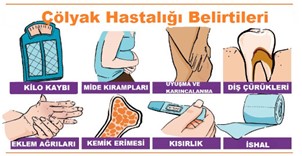What is Celiac Disease?
Celiac disease; occurs as a result of consuming wheat gluten and similar proteins in other cereals and is a food intolerance disorder also called "gluten sensitive intestinal tract". The main factor causing the disorder is the sub-fraction of the gluten protein found in wheat called gliadin. But celiacs should also avoid the consumption of rye and barley products, which include not only wheat, but also prolamines, which are homologs of gliadins.
Gluten causes problems on the small intestine in celiac patients. With the intake of gluten, the protrusions (villi) on the inner surface of the small intestine that ensure absorption are shortened, or even completely eliminated, and the inner surface of the intestine is flattened. The only row of "crypt" cells on the surface of the protrusions is thickened. Thus, the surface where the absorption is made decreases and food intake becomes difficult.
 Symptoms of Celiac Disease
Symptoms of Celiac Disease
Diarrhea, vomiting, loss of appetite, abdominal distension, weight loss, constipation and growth retardation in early childhood (first 2 years) are the classic symptoms of the disease. In children and adults, disorders such as anemia and bone weakness, which cannot be treated or caused, are also symptoms of celiac disease. Celiac disease can occur with typical symptoms at any time. In some individuals, it may be very mild for years without any symptoms. This condition complicates the diagnosis of celiac disease.
For the purpose of diagnosis, endomysium antibodies, antigliadin antibodies and transglutaminase antibodies should be investigated in the blood first. If at least one of these antibodies is positive, it is necessary to perform a small bowel biopsy with suspicion of celiac disease.
Living with Celiac Disease
The only treatment method is a gluten-free diet that should be done for life. In the gluten-free diet, all kinds of nutrients containing wheat, barley and rye flour should be avoided when eaten. However, each patient has different levels of gluten sensitivity. Some patients cannot even tolerate trace amounts of gluten, while other patients can tolerate larger amounts of gluten. Corn and rice, on the other hand, are non-toxic and can be used instead of wheat, barley and rye.
 Today, gluten-free products are produced for celiacs under a special group called "gluten-free foods". These include biscuits, etc., products that are naturally prepared with gluten-free foods (rice, corn and soy flour, as well as guar or amaranth). Gluten-free foods consumed by celiacs are generally poor in some B group vitamins, iron and dietary fiber content compared to other gluten-containing foods because they are produced from refined flour and/or starch and are not enriched. A lactose-free diet is recommended for the first 3 months after receiving a diagnosis of celiac disease. In many celiac patients, there is an improvement in symptoms in the first two weeks of treatment, and it can rarely last up to 6 months. Histological improvement usually occurs within 6-24 months.
Today, gluten-free products are produced for celiacs under a special group called "gluten-free foods". These include biscuits, etc., products that are naturally prepared with gluten-free foods (rice, corn and soy flour, as well as guar or amaranth). Gluten-free foods consumed by celiacs are generally poor in some B group vitamins, iron and dietary fiber content compared to other gluten-containing foods because they are produced from refined flour and/or starch and are not enriched. A lactose-free diet is recommended for the first 3 months after receiving a diagnosis of celiac disease. In many celiac patients, there is an improvement in symptoms in the first two weeks of treatment, and it can rarely last up to 6 months. Histological improvement usually occurs within 6-24 months.